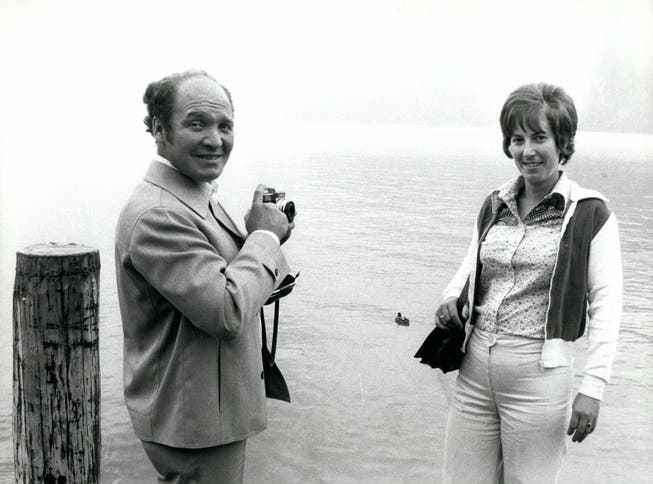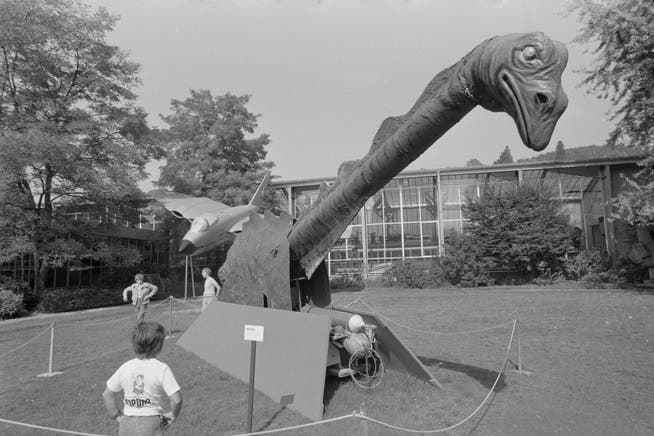In the summer of 1976, TV man Kurt Felix caused a sensation around the world with a monster in Lake Lucerne. The gag almost went wrong. A look back.
The blurred photos of a monster in Lake Lucerne caused a sensation worldwide.
The tranquil spa town of Brunnen experienced a veritable invasion on the last weekend in August 1976. Onlookers have come from all over Switzerland, even from southern Germany and Austria. The people crowding the waterfront all want just one thing: see the monster. The monster that around sixty eyewitnesses claim to have seen in Lake Lucerne the previous Friday.
The reports of the tourists and the locals, who quickly made the rounds far beyond the Swiss borders, all sound similar. Around 11 a.m. on August 28, a few hundred meters from the shore, a dragon-like creature emerged, snorting, out of Lake Uri. After a few moments, the monster disappears again, then comes to the surface twice more, before finally disappearing into the depths. “From the side I saw a head and a wavy back, like a dinosaur,” boat rental company Kurt Mathis told Blick. The tabloid is also convinced that Scotland has received competition and now Switzerland has its Nessie.
Various other newspapers published pictures of the alleged monster the day after. The shaky shots were taken by Rolf Burkart, a tourist from Germany who is spending his holidays on Lake Lucerne. “I wanted to photograph my wife at the lake and suddenly I discovered this monster in the water.” He then snapped a whole film and his wife took photos with an instant camera. “Fortunately we were so quick, my colleagues at home would never have believed it,” said the tourist to the journalists who traveled to Brunnen to hear the sensational news.
Worldwide interest in Swiss Nessie
The news that a sea monster had been sighted in the middle of Switzerland made waves around the world. From Germany to Mexico to Japan, the media are reporting on the unbelievable events in Lake Lucerne. The spa town of Brunnen has to take measures to get the situation under control: many people no longer dare to go out on the lake out of fear or besiege the shore as onlookers. Others have locals take boats out onto the open water to be on the front lines should the Nessie reappear.
As always on such occasions, the time has come for the enterprising. The host of a restaurant offers a “Loch Ness menu” consisting of “seahorse soup, dinosaur Nessie roast with floating buoys and anchor vegetables”.
The “Blick” tries to keep the story simmering in the days that follow. The tabloid reported on August 30 on its front page that the well-known Swiss deep-sea diver Hannes Keller wanted to search the bottom of Lake Uri professionally. “If there really is a monster, I’ll find it,” prophesies the self-proclaimed Nessie hunter, who holds the world record for deep diving at 305 meters.
But the longer the sea monster disappears, the greater the doubt that such a creature is actually in the vicinity of the Rütli meadow. One man is increasingly suspected of being behind this affair: Kurt Felix, one of the best-known TV presenters in Switzerland. The pranks he plays on viewers with a hidden camera on his show “Teleboy” are legendary.
A monster as an insurance case
But the TV darling washes his hands of the media in innocence. At the time the monster was sighted, he was in the studio in Zurich. “Whenever something unusual happens in Switzerland, it’s always been me,” explains Kurt Felix. “I’ve gotten used to that. People should have their faith. But I wasn’t really involved here.” His statements seem credible not least because those responsible for Swiss television know nothing about a shoot with a hidden camera. They are therefore completely taken by surprise by the inquiries, the switchboard almost collapses because journalists from all over the world are inquiring about film footage of Nessie from Lake Uri.

German tourist Rolf Burkart and his wife Rosi took the photos of Nessie that went around the world.
Four days after the first sighting, it is clear that there will be no more monster sightings. After various media did intensive research and pressure, Kurt Felix admits: “Yes, it was me.” At the same time, the show master reveals that it was the most elaborate hidden camera prank to date, in which only a small group of people were privy to. The complex campaign threatened to fail several times.
The first version of the monster only has a short life. The attempt to construct an inflatable sea monster fails miserably because the thing bursts on the first test. The second Nessie is never launched either. In February 1975, a fire broke out in the boathouse on Lake Uri, where Felix and his crew store the building materials, which had nothing to do with the construction of the monster. But the large air tanks, which are supposed to give the monster lift, explode. ‘Can you imagine explaining to an insurance expert that a sea monster burned up in the boathouse along with everything else? He declares you crazy,” says “Teleboy” director Max Sieber, describing the consequences of this fire.
Monster disappears in the deep
With the third version it finally works. The TV people commissioned the deep-sea diver Hannes Keller and the motorboat racer Josef Ulrich from Sisikon (Uri) to construct a seaworthy monster. A Nessie that is around ten meters long and seven meters high is being built on a plastic framework, air tanks and counterweights. After several test runs, which literally take place at night and in fog, the technicians bring the dragon-like monster under the water surface into the desired position in front of Brunnen. As soon as the tow boat attached to the monster’s tail comes to a standstill, the construction emerges from Lake Uri. At the same time, a horrible roar resounds from loudspeakers mounted on the tow boat.
The TV crew remains unlucky. Right at the first of several planned appearances, something happens that should have been avoided at all costs: a boat with curious people on board wants to pass between the Nessie and the tow boat and threatens to cut the tow line. All attempts to scare the intruders away are useless, so the boatman has to step on the gas and Nessie disappears around thirty meters below the surface. “It’s a shame about the monster!” Headlines the “Blick”.
However, Kurt Felix and his team have achieved one thing: they have never had so much free advertising in the media with regard to a “Teleboy” program. On September 4, 1976, a record crowd of 1.5 million viewers sat in front of the television sets. They want what the onlookers in Brunnen wanted: to see the monster. Shortly before the end of the broadcast, technicians who have been working on the construction rescued from the depths until the last minute push the Nessie into the studio.

The Nessie got a temporary home in the Swiss Museum of Transport in Lucerne. It never returned to Lake Lucerne.
On the same evening, the sea monster is shipped to Lucerne, where it is driven through the city shortly after midnight as part of the Lake Night Festival. Later, the plastic monster from Lake Uri finds a place in the Lucerne Museum of Transport. However, it cannot stay there and has to make way for a new attraction. The interest of the population wanes relatively quickly and the monster is scrapped without media coverage.
Not least because of the prank with the monster, people in Germany are paying attention to Kurt Felix. On January 31, 1980, the Swiss broadcaster presented the entertainment program “Verstand Sie Spass?” for the first time, which became a hit with the public on German television – a further development of the “Teleboy”.
